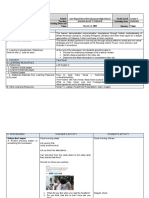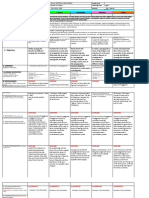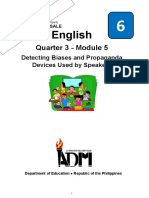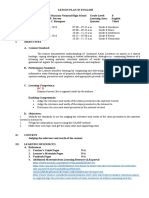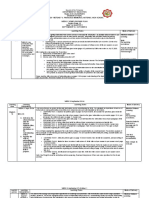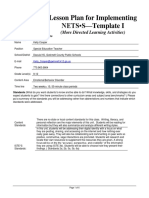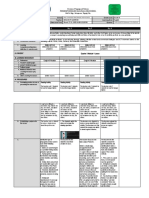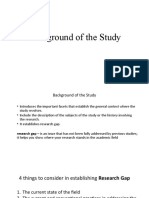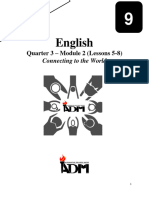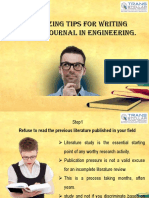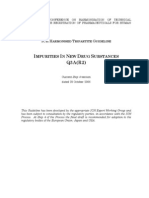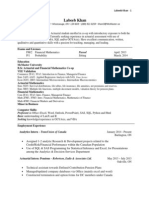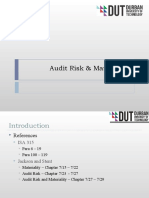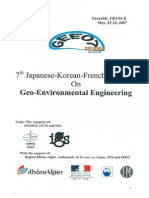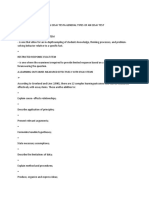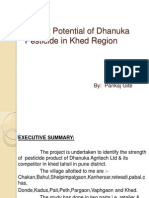DLL MATATAG _ENGLISH 7 Q3 W4
Uploaded by
laleinechua14DLL MATATAG _ENGLISH 7 Q3 W4
Uploaded by
laleinechua14School: STA.
CRUZ INTEGRATED SCHOOL Grade Level: 7
MATATAG Name of Teacher LALEINE B. CHUA Learning Area: ENGLISH
K to 10 Curriculum
Teaching Dates and Time: JANUARY 13 – 17, 2025 (WEEK 5) Quarter: Third
Weekly Lesson Log
I. CURRICULUM CONTENT, STANDARDS, AND LESSON COMPETENCIES
A. Content Standards The learners demonstrate their word knowledge as used in formal and informal situations; knowledge of grammatical structures; literal,
inferential, and critical comprehension of literary and informational texts; composing and creating text skills; and knowledge of non-
verbal cues and propaganda techniques in order to produce culture-based texts based on one’s purpose, context, and target
audience.
B. Performance The learners apply literal, inferential, and critical comprehension of literary and informational texts; produce culture- based texts:
Standards narrative, expository, and persuasive texts appropriate for their purpose, context (Indigenous People and regional celebrations), and
target audience using simple, compound, and complex sentences, and age-appropriate and gender-sensitive language.
C. Learning Learning Competency
Competencies Examine the quality and structure of a news article as a journalistic text.
and Objectives
Learning Objectives
a. Analyze propaganda techniques in a journalistic text (testimonials vs. plain folks; stereotyping vs. fear appeals).
b. Analyze how non-linear texts represent and/or summarize the contents in a journalistic text.
c. Distinguish facts from claims/opinions.
d. Determine the veracity of the information presented.
C. Content Journalistic text (News/Press Release) Propaganda
types and techniques Fact versus opinion
Veracity of information
D. Integration Information literacy and integrity
1
2
II. LEARNING RESOURCES
Calub, C., & Calub, F. (2022). Propaganda in journalism, advertising, and politics. Tarlac State University.
https://www.researchgate.net/publication/361039309_PROPAGANDA_IN_JOURNALISM_ADVERTISING_AND_POLITICS
Davao Today. (2022, June 20). FACT CHECK: NCIP’s claims on the terms Igorot, Lumad, Tumandok are false. Davao Today. https://davaotoday.com/human- rights/fact-check-
ncips-claims-on-the-terms-igorot-lumad-tumandok-are-false/
GMA News. (2020, July 30). ADVISORY: President Duterte declares July 31, Friday, a regular holiday to mark Eid’l Adha or the Feast of Sacrifice, according to Malacañang Palace. |
via Virgil Lopez/GMA News Online. Facebook. https://www.facebook.com/gmanews/photos/a.126333131976/10159091245391977/
Litonjua, T. (2021, February 25). FALSE: Photo proves Alcadev school teaches Lumad kids how to become NPA. Rappler.
https://www.rappler.com/newsbreak/fact-check/alcadev-teacher-admits-teaching-lumad-children-how-to-become-npa/
Rappler. (2020, July 27). FALSE: “No classes for all” in 2020-2021. Rappler. https://www.rappler.com/newsbreak/fact-check/no-classes-for-all-school-year- 2020-2021/
Tantuco, V. (2021, February 25). FALSE: Lumad is a word made up by the CPP-NPA-NDF. Rappler. https://www.rappler.com/newsbreak/fact-check/lumad- word-made-up-
cpp-npa-ndf/
III. TEACHING AND LEARNING PROCEDURE NOTES TO TEACHERS
A. Activating Prior (Days 1 and 2 within 55 minutes each) The teacher may further the
Knowledge review of concepts by illustrating
Short Review Recall and examples from the previous
Match: lesson in Week 4.
The teacher may review the class with the previous lesson on a) diction and style and b)
quoting, paraphrasing, and summarizing. The students answer the worksheet Recall and Answers to the activity:
Match. In this activity, the students review the concepts in the first column by looking for 1. summary (summarizing)
their correct terms in the second column. 2. precision
3. simplicity
4. a paraphrase (paraphrasing)
5. quote
6. brevity
B. Establishing Lesson 1. Lesson Purpose Point and
Purpose Find Out:
The teacher shows this image on the screen or board.
3
As the teacher asks the questions,
they encourage the students to
point out in the image the factors
Photo source: https://www.rappler.com/newsbreak/fact-check/alcadev-teacher- admits- or reasons that make the post
teaching-lumad-children-how-to-become-npa/ false.
The teacher should call upon
The teacher asks the following questions to the students: students to share their answers to
1. What is the false information all about? the questions. Additionally, the
2. Who is involved in the false post? teacher may facilitate small group
3. How is the post made false? discussions (SGDs) during which
4. How is the image used to show false information? students can discuss their
5. How does the false information or post affect you as a reader and the public? experiences with fake news or false
information online or in print.
6. How can we identify whether the news information we read online or in print is correct
or false? During this activity, the teacher
can connect students' answers to
2. Unlocking Content Area Vocabulary Search the lesson on propaganda
Me Up! techniques used in informational
The students answer the worksheet Search me up! Using a dictionary, they look for the texts and explain
word whose meaning is closest or synonymous to the underlined word in each sentence.
The proper use of the dictionary and the subskill
4
‘synonym’ are practiced and enriched through this activity. The teacher may why it is important to verify
also emphasize how meanings can be derived through context clues. information.
The teacher may ask the students
with the synthesis questions to
monitor how they can come up
with their answers.
C. Developing and SUB-TOPIC 1: Propaganda Types and Techniques in Journalistic Texts
Deepening 1. Explicitation The teacher may call some pairs
Understanding to share their answers with the
Pair and Share class. While listening to the
The students answer the worksheet Pair and Share. In this initial activity, students, different observations of the
working in pairs, brainstorm the characteristics that render information false, the students, the teacher may lead them
reasons for spreading such information online, and the potential impact of false to the types of propaganda: white
and black. The students may also
information on both themselves and the public.
be asked whether the posted
information online is white or black
Points for Discussion (Teacher’s Guide) propaganda. The points for
● Propaganda refers to any information disseminated to persuade and discussion may be used as a guide.
influence one’s feelings, beliefs, and actions.
● According to Calub and Calub (2022), propaganda exists because of spreading
rumors or information, either false or correct, to influence public opinion.
● Two general types of propaganda
o White propaganda refers to disseminating information from a credible and
unbiased source; hence, the message is accurate.
o Black propaganda involves spreading false or misleading information to deceive
or manipulate the audience into spreading lies or fabricated information.
The teacher should call some
2. Worked Example
students to share their answers
with the class. The class may even
Activity A: Think and Decide debate the type/s of
5
The students answer the worksheet Think and Decide. In this activity, they examine propaganda presented in the
the information from the graphic, and the Rappler press release FALSE: Photo proves information.
Alcadev school teaches Lumad kids how to become NPA by identifying the prevalent
type of propaganda technique/s used. Then, they discuss how the propaganda/s is/are Further, the teacher may use other
used and their intended effect on the readers/audience. examples to illustrate the different
propaganda techniques in
journalistic writings, such as news
The teacher may use this rubric in scoring the writing activity.
and press releases.
Activity B: Picto-analysis
The students answer the next activity, Picto-analysis. Since the propaganda techniques
found in texts could be enhanced through non-linear texts, such as charts, graphs, or
pictures, this activity allows the students to examine visual elements used to illustrate The teacher should help the
false information propaganda elements. students highlight the visual
elements that illustrate the
Points for Discussion (Teacher’s Guide) propaganda techniques. They may
● Testimonial. Famous or authoritative persons are featured to make a statement about also emphasize how non- linear
the issue. Using personalities to attest to the issue or promote a product or service texts can be used to represent false
increases the credibility and popularity of the issue or product, which invites readers information.
or audiences to believe and be influenced (Calub & Calub, 2022).
● Plain folks. The information is associated with individuals to create an image that
values common people or the masses. This propaganda aims to relate to the
common people by presenting an ordinary, humble person who shares the same
values and experiences as the readers.
● Stereotyping or name calling. Negative words are used to create an emotional
response, often aimed at discrediting someone or to create a negative opinion
about someone. Calub and Calub (2022) said this
6
10-7 6-4 3-1
The ideas are The ideas are The ideas are
relevant, relevant, but relevant, but
complete, the amount no
and of explanation is
comprehensi informa provided.
tion is
ve. inadequ
ate.
The ideas are The ideas are The ideas are
logically somewhat not
and logically and logically and
coherent coherently coherently
ly explained. explained.
explaine
d.
7
propaganda involves using “derogatory phrases to create a negative opinion about someone” or
an issue (p. 3).
● Fear appeal. The information is created to influence someone by causing fear or anxiety in
the audience. This propaganda aims to give the readers or audience an idea about the
possible frightening or horrible circumstance and how it can be avoided.
The teacher may use this rubric in scoring the writing activity.
10-7 6-4 3-1
The ideas are The ideas are relevant, The ideas are relevant,
relevant, complete, but the amount of but no explanation is
and comprehensive. information is provided.
inadequate.
The ideas are logically The ideas are somewhat The ideas are not
and coherently logically and coherently logically and coherently
explained. explained. explained.
3. Lesson Activity
Surveying Propaganda Techniques
In this part of the lesson, the students answer the activity in which they examine the information
in the graphics and from the press releases by identifying the type of propaganda and the
propaganda techniques used. They use the checklist in surveying the techniques.
8
SUB-TOPIC 2: Fact versus Opinion (Days 1 and 2 within 55 minutes
each)
1. Explicitation
The teacher posts these images on the board or screen.
Image B
Image A
Photo source: Photo source: https://www.rappler.com/newsbreak/fact-
9
10
The students then answer the activity. Pen Your Observation. In this preliminary task, the students identify which image contains more factual and credible
information. They write their observation by noting the details and how they are delivered to the public.
While the teacher is processing answers to the activity, they may ask the students the following
questions:
1. What makes the information in Image A more factual or credible?
11
2. How are the facts presented in Image A?
3. Why is the information in Image B not reliable?
4. How does Image B affect you as a reader?
2. Worked Example
Activity A: Fact or Opinion?
In this activity, the teacher groups the class with 4-5 members. Each group is given ten
cards that contain factual and opinionated statements. Then, each group sorts out the
fact or opinion cards within one minute.
The following are sample statements that the teacher can use.
1. There are more than 100 languages in the Philippines.
2. The sun is a star.
3. I think the iPhone is better than the Android.
4. From my point of view, swimming is better than basketball. The teacher may do the activity in
5. PBBM is the 17th president of the Philippines. the form of a game. Further, they
6. I love reading books. may use other statements besides
7. Aristotle said, “Happiness depends upon ourselves.” the pre-identified ones.
8. Boxing is the most exciting sport in the Philippines.
Answers:
9. Indonesia is part of Southeast Asia.
1. Fact
10. Banana is rich in potassium. 2. Fact
3. Opinion
The teacher leads the class discussion by using the statements in the cards. 4. Opinion
5. Fact
Points for Discussion (Teacher’s Guide) 6. Opinion
● A fact is a generally acceptable statement that can be proven true based on 7. Fact
objective evidence. In other words, the statement is verifiable by truthful accounts 8. Opinion
9. Fact
(figures, dates, statistical reports, research findings, etc.).
10. Fact
● A fact is an event that happens, is happening, or has happened.
● Facts are essential and crucial for understanding and evaluating information from
multimodal platforms and forming informed opinions and decisions.
● Factual statements are supported with references and expressions like
‘according to,’ ‘based on the study of,’ or ‘Einstein said.’
12
● An opinion, on the other hand, is a statement of feelings or viewpoints about a
subject that may not be based on evidence or may not be verifiable by truthful
accounts.
● An opinion may be believed to exist or have occurred, but the evidence may not
be objective and reliable.
● Most opinionated statements use signal phrases like, 'I think,' 'I believe,' 'In my
opinion,' 'In my viewpoint/point of view,' 'In my reason,' or adjectives, such
as 'good,' 'better,' 'the best' unless proven. These words and phrases represent
personal feelings, attitudes, or views.
Activity B: Room Domination
The teacher groups the class into two.
Each group selects one representative. Then, the two student representatives stand
together at the front and quickly identify each flashing statement as either fact or
opinion by raising their right hand. The first to raise a hand guesses the answer; once
they answer correctly, their group earns a point. The student with the most correct
answers wins for their group and takes control of the room. Meanwhile, each group
has the option to change representatives during the game.
The following are sample statements that the teacher can use.
1. Cebu is the best city in the world.
2. The earth is round.
3. I think listening to rock music distracts attention.
4. Singapore is the capital city of Singapore.
5. Today seems hotter than yesterday. The teacher may use other
statements besides the pre-
identified ones.
3. Lesson Activity
Let’s Fact-Check! Answers:
In this activity, the students examine the information of the excerpts from Rappler 1. Opinion
press release FACT CHECK: NCIP’s claims on the terms Igorot, Lumad, Tumandok are 2. Fact
false by identifying which text contains factual or opinionated information. 3. Opinion
4. Fact
5. Opinion
13
After the students answer the activity, the teacher leads the processing of answers by
returning to the discussed concepts. The teacher must help the students examine how Answers:
language is used to present factual and opinionated statements. 1. Text A-Opinion
Text B-Fact
The teacher may use this rubric in scoring the writing activity. 2. Text A-Fact Text
B-Opinion
10-7 6-4 3-1
The ideas are relevant, The ideas are relevant, The ideas are relevant,
complete, and but the amount of but no explanation is
comprehensive. information is provided.
inadequate.
The ideas are logically The ideas are somewhat The ideas are not
and coherently logically and coherently logically and coherently
explained. explained. explained.
D. Making 1. Learners’ Takeaways If instructional time permits, the
Generalizations Grab a graph teacher may add similar activities
The teacher may group the class for this activity. For this part, the students create if the students do not perform
personalized infographics to summarize their knowledge/learning on a) propaganda types satisfactorily in the learning tasks.
and techniques and b) fact versus opinion. Afterward, the teacher may do a gallery walk They may design one or two
of infographics inside the classroom as the students discuss their works. challenging activities when the
students manifest a thorough
The teacher may require the students to digitize or draw their infographics on paper. The understanding of the lessons or
teacher may provide contextualized guidelines for this activity. Further, they should easier ones when the students
provide the students with enough time to finish the activity. perform poorly in the tasks.
2. Reflection on Learning How do
I fair? The teacher may call some
The students answer the worksheet How do I fair? in which they reflect on their students to share their work with
strengths and weaknesses in examining propaganda statements and factual and the class.
opinionated information in texts.
IV. EVALUATING LEARNING: FORMATIVE ASSESSMENT AND TEACHER’S REFLECTION NOTES TO TEACHERS
14
A. Evaluating Formative Assessment
Learning For the evaluation of learning, the students answer the 10-item test.
A. Identification
Instructions: Identify what is described or asked in each item.
1. This refers to information disseminated to influence and convince one’s
feelings, beliefs, and actions. Answers:
2. Liza watches TV news programs to get updates on the Barangay and A.
Sangguniang Kabataan Elections 2023. What general type of propaganda is 1. propaganda
2. white propaganda
shown in this situation?
3. black propaganda
3. When false information is posted on Facebook, it tends to mislead and deceive
4. stereotyping or name-calling
readers. What general type of propaganda is exhibited in this situation? 5. testimonial
4. This propaganda technique uses negative words to create a negative opinion about
someone or something. B.
5. An authoritative person, like a politician, is featured to make a statement about 6. O
an issue. 7. F
8. O
B. Fact or Opinion 9. O
Instructions: Write F if the statement contains a piece of factual information; otherwise, 10. F
write O if the statement includes a piece of opinionated information.
6. I think apples are sweeter than mangoes.
7. According to the Food and Nutrition Research Institute, green leafy
vegetables are rich in Vitamin A.
8. It is always good to start a day with coffee.
9. Cooking with wood or charcoal is more dangerous than using fuel gas.
10. Eggplant is botanically considered a fruit, not a vegetable.
B. Teacher’s Note observations on any On the instructional materials (IMs)
Remarks of the following areas: utilized
Effective Practices Problems Encountered ● During the teaching-learning
process, the teacher may
15
strategies explored note the problems encountered
by the students in reading the
texts.
● Should the teacher feel the text
is inappropriate for the
student’s grade level, they may
materials used look for another material that
still develops the same learning
competencies.
On learner engagement/interaction
learner engagement/ ● The teacher may note the
interaction students' attitude towards others
during paired or group activities,
such as debates, group
discussions, etc. The teacher may
use the observations as bases for
others future group learning tasks.
C. Teacher’s Reflection guide or prompt can be on: There are many ways of teaching
Reflection ▪ Principles behind the teaching propaganda types and techniques. The
What principles and beliefs informed my lesson? Why did I teacher may explore other activities if
the model activities in this lesson
exemplar do not work with the
teach the lesson the way I did?
students.
● After teaching the lessons, the
teacher may note the topics
▪ Students the students did not
What roles did my students play in my lesson? What did my understand well, especially
identifying propaganda
students learn? How did they know? techniques and examining
facts versus opinions.
● Students’ misconceptions
about propaganda
▪ Ways forward techniques and facts and
What could I have done differently?
16
opinions may serve as
What can I explore in the next lesson? inputs for review in the next
session.
Prepared by: Submitted to:
LALEINE B. CHUA BERSEFLOR D. CURAMBAO
Grade 7- Teacher School Principal I
17
You might also like
- ACT and RFT in Relationships Helping Clients Deepen Intimacy and Maintain Healthy Commitments Using Acceptance and Commitment Therapy and Relational Frame Theory by JoAnne Dahl PhD, Ian Stewart PhD, C (Z-lib.o (1100% (1)ACT and RFT in Relationships Helping Clients Deepen Intimacy and Maintain Healthy Commitments Using Acceptance and Commitment Therapy and Relational Frame Theory by JoAnne Dahl PhD, Ian Stewart PhD, C (Z-lib.o (1298 pages
- Guide For Electric Motor Stator Winding Insulation Design, Testing and VPI Resin Treatment50% (2)Guide For Electric Motor Stator Winding Insulation Design, Testing and VPI Resin Treatment102 pages
- Teacher's Needs Assessment Survey Checklist100% (3)Teacher's Needs Assessment Survey Checklist5 pages
- DETAILED-LESSON-PLAN-IN-ENGLISH-7-Jan-20-21 (1)No ratings yetDETAILED-LESSON-PLAN-IN-ENGLISH-7-Jan-20-21 (1)10 pages
- Besana Online Final Lp-For-Demo April-06-2024100% (1)Besana Online Final Lp-For-Demo April-06-202411 pages
- ENGLISH 8-Q3-Mod2-Week3-4-Analyze Intention of Words or Expressions Used in Propaganda Technique88% (16)ENGLISH 8-Q3-Mod2-Week3-4-Analyze Intention of Words or Expressions Used in Propaganda Technique23 pages
- September 13-October 6: Republic of The Philippines Department of Education Region Iv-A Calabarzon Division of RizalNo ratings yetSeptember 13-October 6: Republic of The Philippines Department of Education Region Iv-A Calabarzon Division of Rizal4 pages
- September 13-October 6: Republic of The Philippines Department of Education Region Iv-A Calabarzon Division of Rizal100% (1)September 13-October 6: Republic of The Philippines Department of Education Region Iv-A Calabarzon Division of Rizal4 pages
- MR.LAZATIN COT3-Semi-Detailed Lesson planNo ratings yetMR.LAZATIN COT3-Semi-Detailed Lesson plan4 pages
- Lesson Plan For Implementing NETS - S-Template I: (More Directed Learning Activities)No ratings yetLesson Plan For Implementing NETS - S-Template I: (More Directed Learning Activities)6 pages
- Background of The Study, Research Questions, Hypothesis, Scope and Delimitaion, Significance of The StudyNo ratings yetBackground of The Study, Research Questions, Hypothesis, Scope and Delimitaion, Significance of The Study12 pages
- Green Yellow Aesthetic Cute Notebook Group Project Presentation.pdfNo ratings yetGreen Yellow Aesthetic Cute Notebook Group Project Presentation.pdf25 pages
- Eng6 - Q2 Module 2 - Week2 DETECTING BIASES AND PROPAGANDA DEVICES - Removed100% (1)Eng6 - Q2 Module 2 - Week2 DETECTING BIASES AND PROPAGANDA DEVICES - Removed13 pages
- English: Quarter 1 - Module 1: Using Information Sources in Everyday Life0% (1)English: Quarter 1 - Module 1: Using Information Sources in Everyday Life27 pages
- Stand On Issues Supported by Factual EvidencesNo ratings yetStand On Issues Supported by Factual Evidences7 pages
- LESSON 8 Qualitative and Quantitative ReserachNo ratings yetLESSON 8 Qualitative and Quantitative Reserach19 pages
- Relationship of Risks To Evidence and Factors Influencing Risks100% (1)Relationship of Risks To Evidence and Factors Influencing Risks2 pages
- 10 T-Test (One Mean) Chavez, Gabreille R.No ratings yet10 T-Test (One Mean) Chavez, Gabreille R.12 pages
- Environmental Research: Qihong Deng, Linjing Deng, Chan Lu, Yuguo Li, Dan NorbäckNo ratings yetEnvironmental Research: Qihong Deng, Linjing Deng, Chan Lu, Yuguo Li, Dan Norbäck9 pages
- IB Mathematics Internal Assessment - Standard LevelNo ratings yetIB Mathematics Internal Assessment - Standard Level21 pages
- ICH Q3A R2 - IMPURITIES IN NEW DRUG SUBSTANCES - Guia ICH para Determinação de Impurezas de Novas Drogas100% (3)ICH Q3A R2 - IMPURITIES IN NEW DRUG SUBSTANCES - Guia ICH para Determinação de Impurezas de Novas Drogas15 pages
- Leblanc (2019) Tackling wicked problemsNo ratings yetLeblanc (2019) Tackling wicked problems62 pages
- Capacity Building Trainings For Polytechnic Colleges Vocational CounselingNo ratings yetCapacity Building Trainings For Polytechnic Colleges Vocational Counseling23 pages
- "It Gets Better" Internet Memes and The Construction of Collective IdentityNo ratings yet"It Gets Better" Internet Memes and The Construction of Collective Identity17 pages





